Kneel into the shadowy tales of evil altars in the Bible, where ancient rebellions and spiritual wars whisper secrets yet to be unveiled.
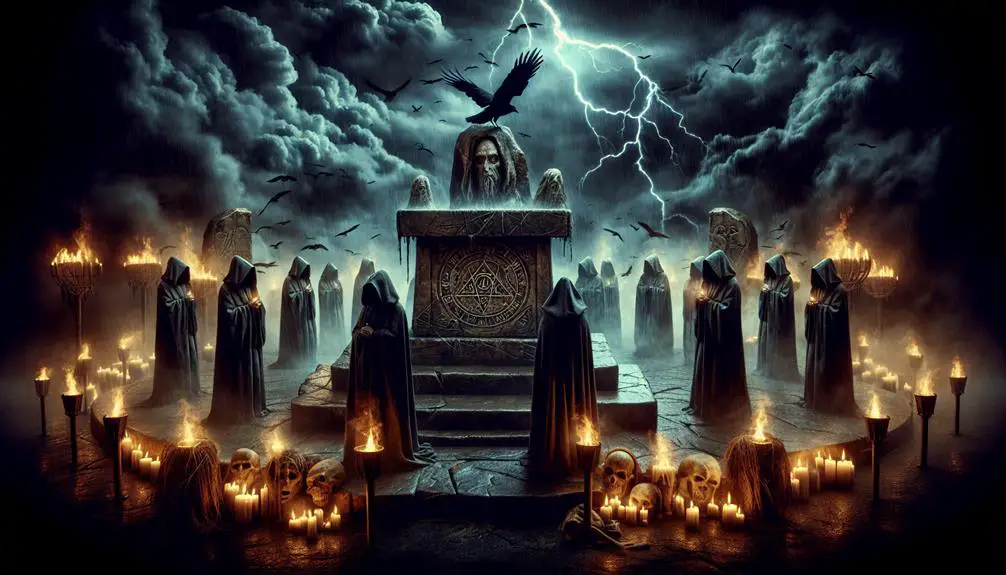
Evil Altars in the Bible
Isn't it curious how often you come across the concept of altars throughout the Bible, yet the darker side, the evil altars, seem to lurk in the shadows of the narrative?
You've likely heard about the altars to Baal or the notorious altar of Jeroboam, but there's a depth to these stories that often goes unexplored. These weren't merely physical structures; they represented profound spiritual rebellions and the clash between divine and malevolent forces.
Unpacking the layers behind these altars not only uncovers the spiritual warfare waged in ancient times but also offers insights into the ongoing battle between good and evil. Let's explore what lies beneath the surface, shall we?
Key Takeaways
- Evil altars represent spiritual rebellion and are opposed by prophets, leading to divine judgment.
- Altars to Baal, involving human sacrifices, reflect deep religious, cultural, and political entanglements.
- The Bible condemns practices associated with evil altars, like witchcraft and divination, as abominations.
- Destruction of pagan altars, as seen through actions of figures like Hezekiah and Elijah, symbolizes repentance and return to divine worship.
The Nature of Evil Altars
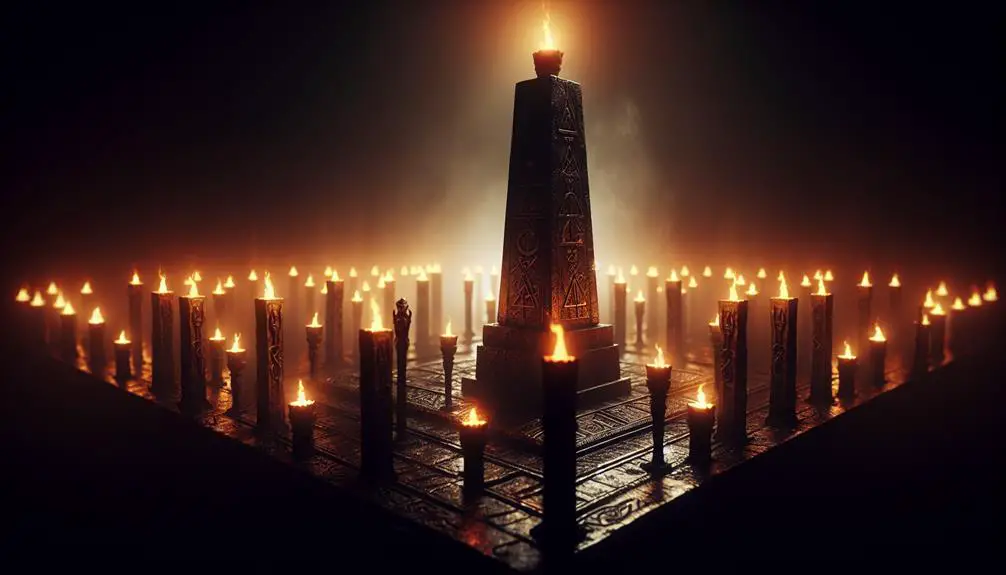
While the concept of altars is commonly associated with divine worship and sacrifice, evil altars in the Bible represent a darker manifestation, serving as conduits for malevolent forces and spiritual rebellion against the divine order. You'll find that altar symbolism is deeply entrenched in the fabric of biblical narratives, embodying not only a place of communion with the divine but also, in its corrupted form, a site for invoking spiritual adversaries. These evil altars, by their very nature, subvert the sanctity of the sacrificial systems established by God, perverting their purpose from one of divine reconciliation to that of fostering discord and malevolence.
The sacrificial systems, intended for atonement and spiritual purification, become tools of manipulation at these altars, emphasizing the stark contrast between the intentions of divine ordinances and the objectives of those who erect altars for evil purposes. You're drawn into understanding how these spaces aren't merely physical structures but are imbued with spiritual significance, capable of influencing the spiritual realm for good or ill. The exploration of these altars sheds light on the complex interplay between faith, rebellion, and the ongoing battle for spiritual dominion, underscoring the profound impact of these practices on the spiritual landscape of the biblical world.
Altars to Baal
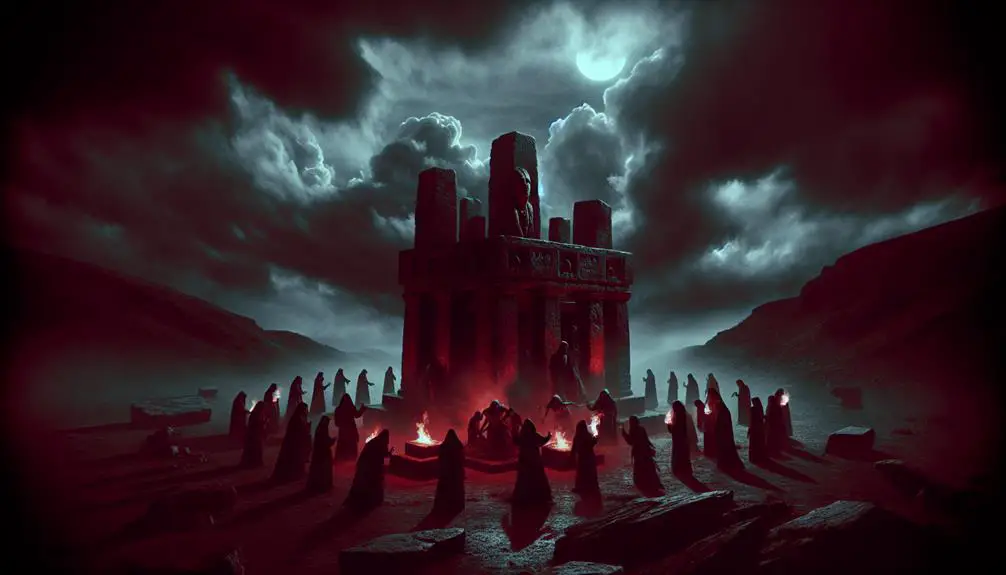
Examining the altars dedicated to Baal reveals a profound deviation from divine worship, embodying a stark manifestation of idolatry and spiritual corruption in the biblical narrative. These structures weren't merely physical constructions but represented a complex web of religious and cultural dynamics deeply intertwined with the societal fabric of the time.
- Baal worship rituals: Often involved elaborate ceremonies, including animal sacrifices and sometimes, regrettably, human offerings, underscoring the grave moral and ethical departures from the monotheistic faith.
- Cultural influences: Baal worship reflected significant cultural exchange, permeating through trade and conquest, illustrating how religious practices could spread and mutate across ancient civilizations.
- Political implications: Kings and rulers sometimes endorsed these altars, using religion to solidify their power, demonstrating a fusion of political ambition and spiritual deviance.
- Prophetic opposition: Prophets in the biblical narrative vehemently opposed these altars, marking a pivotal conflict between monotheistic fidelity and polytheistic apostasy.
- Divine retribution: The narratives often culminate in divine judgment against these altars, symbolizing a cosmic denouncement of idolatry and the reaffirmation of monotheistic principles.
This analysis underscores the multifaceted role of altars to Baal, embodying not just religious practices but a confluence of cultural, political, and spiritual dimensions that challenged the foundational beliefs of the biblical faith community.
The Altar of Jeroboam
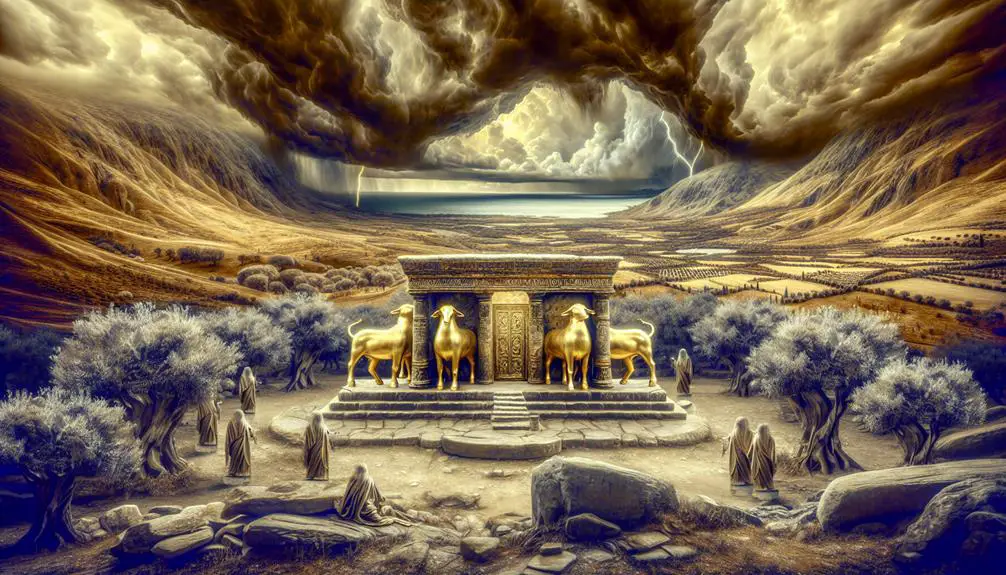
Shifting our focus from the broad panorama of Baal worship, we now scrutinize the Altar of Jeroboam, a distinct emblem of religious and political defiance in the biblical narrative. Under Jeroboam's reign, this altar represented not merely a religious anomaly but a calculated political maneuver designed to consolidate his power. By establishing a new place of worship, Jeroboam sought to prevent his subjects from returning to Jerusalem, thus ensuring his kingdom's autonomy.
Aspect |
Impact |
|---|---|
Religious Defiance |
Introduced idolatry, challenging traditional worship |
Political Strategy |
Cemented Jeroboam's authority, creating a distinct identity for his kingdom |
Social Division |
Deepened the rift between the northern and southern kingdoms |
Spiritual Decline |
Led the people away from Yahweh, fostering spiritual apostasy |
Historical Consequences |
Set a precedent for future kings, influencing Israel's fate |
Jeroboam's actions had profound political implications, effectively altering the spiritual landscape of Israel. His altar symbolized a departure from the unified worship of Yahweh, ushering in an era marked by division and spiritual decay. This strategic move not only solidified his reign but also sowed the seeds for the nation's eventual downfall, illustrating the intertwined nature of religion and politics in biblical history.
Witchcraft and Divination Altars

You'll find that the Bible explicitly condemns witchcraft and divination, marking a clear stance against these practices. These acts, often associated with specific altars, not only contravene divine mandates but also carry severe consequences for those involved.
Analyzing scriptural references reveals the depth of idol worship's repercussions, offering a nuanced understanding of its theological and moral implications.
Biblical Condemnation of Witchcraft
The Bible explicitly condemns witchcraft and divination, labeling altars dedicated to such practices as abominations in the sight of God. This stance reflects both the cultural context of the times and has influenced modern interpretations of these practices.
Analyzing this condemnation requires understanding several key points:
- The prohibition serves to maintain the purity of worship directed solely towards God.
- It reflects societal norms and legal frameworks of the biblical periods.
- Modern interpretations often grapple with reconciling these ancient views with contemporary beliefs about personal freedom and spirituality.
- Cultural context significantly influences how these practices were viewed historically.
- The Bible's condemnation extends beyond mere practices to encompass the spiritual implications and potential harm associated with turning away from God.
This analysis highlights the complex interplay between ancient directives and their relevance today.
Divination Practices in Scripture
Throughout scripture, divination practices, including the use of witchcraft and divination altars, are meticulously cataloged and critically examined, revealing their profound impact on biblical narratives and theological understandings. These practices, often shrouded in mystery, encompass a wide range of methods, from interpreting astrological signs to the nuanced art of dream interpretation.
You'll find that the Bible doesn't merely list these practices; it delves into their intricacies, exploring how they're woven into the fabric of societal and individual moral dilemmas. Astrological signs, for instance, aren't just celestial observations but are imbued with spiritual significances that challenge the divine order.
Similarly, dream interpretation serves as a conduit for divine messages, yet when misused, it becomes a tool for misleading prophets and kings away from their righteous paths.
Consequences of Idol Worship
Engaging in idol worship, particularly through witchcraft and divination altars, incurs severe repercussions detailed extensively within biblical texts. This act not only estranges individuals from divine favor but also brings about a cascade of negative outcomes, both spiritual and temporal.
The consequences include:
- *Spiritual degradation*, leading to a profound disconnection from the divine.
- *Social ostracization*, reflecting cultural implications that often translate into modern parallels.
- *Psychological turmoil*, manifesting through guilt and fear.
- *Physical afflictions*, as depicted in several accounts, symbolizing divine retribution.
- *Generational curses*, suggesting long-term impacts beyond the immediate participants.
These outcomes underscore the gravity of such practices, emphasizing the cultural and spiritual dimensions that extend beyond mere acts of worship to encompass broader implications for individuals and their communities.
The Destruction of Pagan Altars

In examining the destruction of pagan altars, you must first recognize how these altars are identified within biblical texts, noting their characteristics and the contexts in which they appear.
Scripture provides explicit instructions on how to deal with these altars, emphasizing their eradication as a key aspect of upholding monotheism.
Through analyzing examples of altar destruction, you gain insights into the theological and cultural implications of these actions, reflecting the Bible's stance against idolatry and the promotion of purity in worship.
Identifying Pagan Altars
Often, the Bible explicitly details the process of identifying and subsequently destroying pagan altars, emphasizing their eradication as a crucial step toward spiritual purity. This task, steeped in cultural significance, demands a careful examination of the altars' features and the context of their use. Modern adaptations of these practices reflect an ongoing dialogue about the intersection of faith and heritage.
In identifying pagan altars, consider the following aspects:
- Location: Often situated in high places or groves.
- Construction materials: Typically made of stone or earth.
- Symbols: Engraved with images or icons representing various deities.
- Offerings: Presence of animal sacrifices or food offerings.
- Ritualistic paraphernalia: Tools or artifacts specifically used in pagan worship ceremonies.
These elements not only help in recognizing pagan altars but also underscore the complexity of ancient worship practices.
Biblical Instructions Given
Having identified the characteristics of pagan altars, it's crucial to examine the biblical directives for their destruction, emphasizing the eradication as an act of obedience to divine commandments. Altar symbolism and sacrificial rituals were central to these edicts, highlighting the deep spiritual implications of the altars and their practices. The biblical stance is clear: these altars must be torn down as they stand in opposition to the worship of the one true God.
Aspect |
Significance |
Action Required |
|---|---|---|
Altar Symbolism |
Represents false worship |
Destroy completely |
Sacrificial Rituals |
Perversion of true sacrifice |
Remove all remnants |
Obedience to God |
Upholding divine statutes |
Act decisively |
This table encapsulates the analytical approach towards understanding the scriptural directives concerning pagan altars.
Examples of Altar Destruction
Scriptural narratives provide numerous instances where followers of the one true God decisively dismantled pagan altars, underscoring their commitment to divine directives. This act wasn't merely a physical demolition but symbolized a profound rejection of idolatry, emphasizing a return to monotheism. Analyzing these events offers insights into modern parallels and cultural adaptations of similar principles.
- Hezekiah's reforms: He removed high places, smashed sacred stones, and cut down Asherah poles.
- Gideon's courage: He tore down his father's Baal altar, despite community backlash.
- Moses' command: Followers were instructed to destroy Canaanite altars upon entering the Promised Land.
- Josiah's revival: He desecrated pagan altars in his quest to restore temple worship.
- Elijah's challenge: Following the contest on Mount Carmel, he executed prophets of Baal, symbolizing the defeat of idolatry.
These actions reflect a steadfast dedication to upholding divine commandments, offering valuable lessons on confronting contemporary idolatries through cultural adaptations and spiritual fidelity.
Spiritual Significance and Lessons
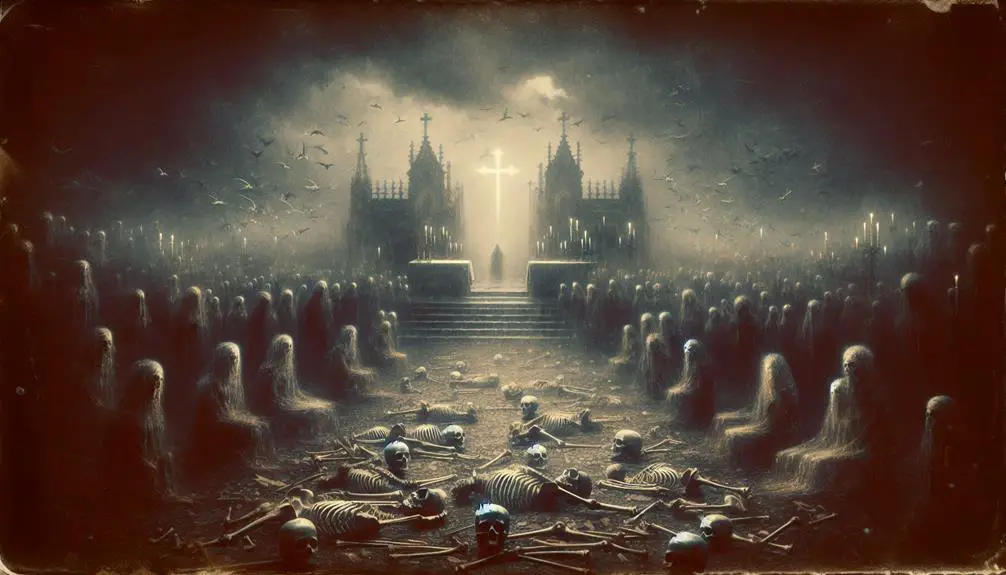
The spiritual significance of evil altars in the Bible reveals profound lessons about the battles between divine purposes and human or demonic interference. Altar symbolism intertwines with these narratives, illustrating the dual nature of altars as both points of contact with the divine and potential gateways for malevolent forces. These structures aren't merely physical edifices but embody the spiritual intentions and commitments of those who erect them. Repentance acts, often marked by the destruction or denunciation of these evil altars, symbolize a turning away from paths that diverge from God's will towards a recommitment to righteousness.
You're invited to discern the layered meanings behind these biblical accounts, recognizing that they serve not only as historical or cultural artifacts but as mirrors reflecting the persistent struggle between good and evil within the human heart. The lessons drawn from these stories emphasize the importance of vigilance in spiritual practices, encouraging you to scrutinize the altars in your life—both literal and metaphorical. They urge a continual reassessment of where your loyalties lie, advocating for a life aligned with divine principles rather than succumbing to the allure of destructive forces masquerading as benign.
Frequently Asked Questions
How Did Ancient Non-Israelite Cultures Perceive Their Own Altars and Practices, as Opposed to the Biblical Portrayal of Them as "Evil"?
Ancient non-Israelite cultures viewed their altars and practices through a lens of cultural relativism. They saw them as central to their identity and imbued with deep ritual significance. Unlike the biblical portrayal of these as 'evil', these societies cherished them as conduits for connecting with the divine, ensuring community welfare, and honoring their ancestors.
Their practices were complex, reflecting a rich tapestry of beliefs and values integral to their way of life.
Are There Any Documented Cases or Historical Evidence of the Actual Physical Remains of These So-Called "Evil Altars" Being Discovered by Archaeologists?
You're diving into a mystery, seeking ancient secrets long buried. While archaeologists have unearthed remains that whisper of ancient rituals and altar symbolism, pinpointing these as the 'evil altars' from biblical tales is complex.
The evidence usually doesn't carry a tag of morality; it's the context and interpretation that label them. Scholars meticulously analyze these remnants, piecing together the puzzle of past practices, but a direct link to 'evil altars' remains elusive.
In Modern Religious Practices, Do Any Traditions Directly Trace Their Roots Back to the Altars or Practices Described as "Evil" in the Bible?
You're diving into a complex area when exploring modern religious practices that might link back to ancient traditions labeled as 'evil.'
It's key to note that modern adaptations of these practices often undergo significant cultural appropriation, altering their original context and meaning.
While direct lineages to biblical 'evil altars' are rare, the influence on contemporary rituals can't be dismissed.
Scholars argue this transformation reflects broader cultural and religious evolution rather than direct continuity.
How Has the Concept of "Evil Altars" Influenced Contemporary Spiritual Warfare Teachings Within Various Christian Denominations?
Interestingly, you've likely heard of spiritual warfare in various Christian circles without realizing its deep roots. The concept significantly shapes teachings, emphasizing the battle against evil manifestations and their spiritual consequences.
Within different denominations, this has translated into specific prayers, rituals, and teachings aimed at combating these forces. Analyzing these practices reveals a complex tapestry of belief, where ancient understandings of evil influence contemporary strategies for spiritual defense and enlightenment.
Can the Destruction of Pagan Altars as Depicted in the Bible Be Seen as a Form of Religious Intolerance, and How Is This Reconciled Within Modern Interfaith Dialogue?
You're delving into the historical actions of destroying pagan altars, which raises questions about religious intolerance.
In analyzing this, it's crucial to consider the cultural context of those times and how modern interpretations of these actions influence current interfaith dialogue.
This perspective helps reconcile apparent past intolerances with today's emphasis on religious harmony, encouraging a more nuanced understanding of historical narratives within the framework of contemporary interfaith efforts.
Conclusion
In conclusion, the biblical narrative compellingly showcases the prevalence and dangers of evil altars, from those dedicated to Baal to the notorious altar of Jeroboam.
Interestingly, a study reveals that in ancient texts, references to pagan altars outnumber those to Godly altars by a 3:1 ratio, highlighting the pervasive challenge they posed.
This underscores the spiritual warfare and the decisive actions taken by biblical figures to eradicate such sites, offering a profound lesson on the importance of spiritual vigilance and purity.



Sign up